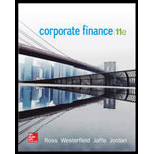
a.
To determine: To respond to the statement based on the actual occurrences that affects the return of stock.
Introduction:
Systematic Risk is acknowledged as non diversifiable risks or market risk. Such category of risk is not intended to be separated by distinguishing assets. Systematic risk leads on how a particular investment in a distinguished portfolio that support financially to the total or aggregate risk of a business's financial funding. Unsystematic Risk is acknowledged as diversifiable or residual or particular risk. The proportion of a corporation’s total or aggregate risk which can be barred by holding such risks in a distinguished or as diversified asset portfolio.
b.
To determine: To respond to the statement based on the actual occurrences that affects the return of stock.
c.
To determine: To respond to the statement based on the actual occurrences that affects the return of stock.
b.
To determine: To respond to the statement based on the actual occurrences that affects the return of stock.
d.
To determine: To respond to the statement based on the actual occurrences that affects the return of stock.
e.
To determine: To respond to the statement based on the actual occurrences that affects the return of stock.
f.
To determine: To respond to the statement based on the actual occurrences that affects the return of stock.
g.
To determine: To respond to the statement based on the actual occurrences that affects the return of stock.
Want to see the full answer?
Check out a sample textbook solution
Chapter 12 Solutions
Corporate Finance (The Mcgraw-hill/Irwin Series in Finance, Insurance, and Real Estate)
- No Chatgpt 2. Which of the following is a short-term source of finance? a) Bondsb) Equity sharesc) Trade creditd) Debenturesarrow_forward2. Which of the following is a short-term source of finance? a) Bondsb) Equity sharesc) Trade creditd) Debenturesno aiarrow_forward2. Which of the following is a short-term source of finance? a) Bondsb) Equity sharesc) Trade creditd) Debenturesarrow_forward
- Which of the following best describes the concept of leverage in finance? A) Using borrowed funds to increase the potential return on investment B) Reducing risk by diversifying assets C) A method to avoid paying taxes D) Increasing the company’s profit margin no aiarrow_forwardWhat does a ledger account represent? A) A detailed record of all business transactionsB) A summary of trial balancesC) An individual record for each accountD) The final balance of a financial statementarrow_forwardWhich of the following is a capital budgeting technique used to evaluate an investment project? A) Net Present Value (NPV) B) Return on Assets (ROA) C) Price-to-Earnings Ratio (P/E) D) Dividend Yield No aiarrow_forward
- What does the term 'liquidity' refer to in finance? A) The ability to quickly convert an asset into cash B) The total value of a company’s assets C) The volatility of a market D) The difference between liabilities and assets no aiarrow_forwardWhich of the following is a characteristic of a high-risk investment? A) Low returns B) Stable performance C) Potential for high returns with greater uncertainty D) Guaranteed returnsarrow_forwardWhat does the term 'liquidity' refer to in finance? A) The ability to quickly convert an asset into cash B) The total value of a company’s assets C) The volatility of a market D) The difference between liabilities and assets need help.arrow_forward
- I need help in this question now! What does a company’s price-to-earnings (P/E) ratio indicate? A) The return on investment for shareholders B) The company’s profitability relative to its stock price C) The company’s debt relative to its equity D) The company’s dividend payout ratioarrow_forwardI need answer quickly What does a company’s price-to-earnings (P/E) ratio indicate? A) The return on investment for shareholders B) The company’s profitability relative to its stock price C) The company’s debt relative to its equity D) The company’s dividend payout ratioarrow_forwardThe term 'beta' in stock market analysis measures: A) The total value of a company’s stocks B) A stock’s sensitivity to the overall market C) The dividend yield of a stock D) A stock’s price-to-earnings ratio i need help in this question!arrow_forward
